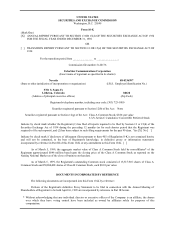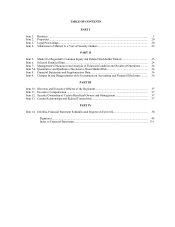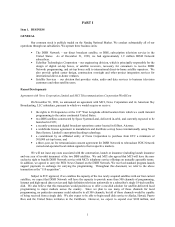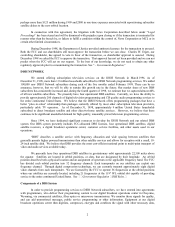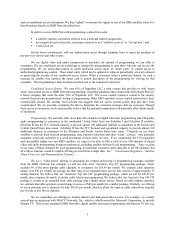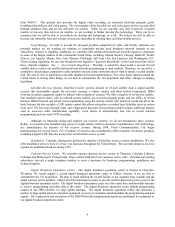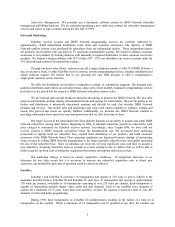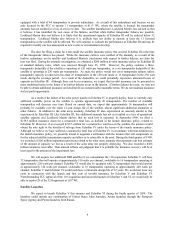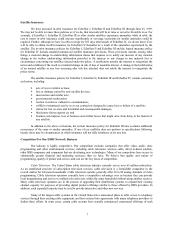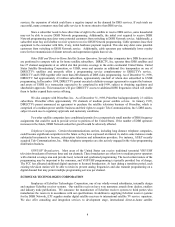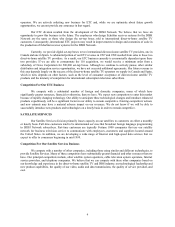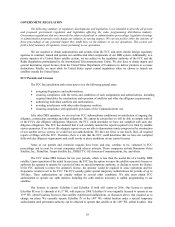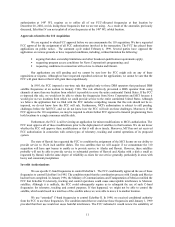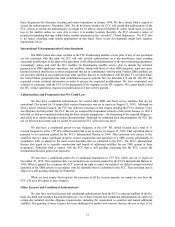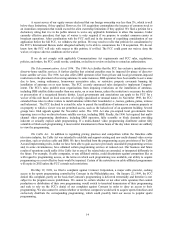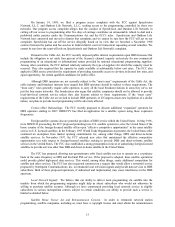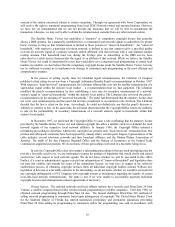Dish Network 1998 Annual Report Download - page 8
Download and view the complete annual report
Please find page 8 of the 1998 Dish Network annual report below. You can navigate through the pages in the report by either clicking on the pages listed below, or by using the keyword search tool below to find specific information within the annual report.6
equipped with a total of 44 transponders to provide redundancy. As a result of this redundancy and because we are
only licensed by the FCC to operate 11 transponders at 61.5° WL, where the satellite is located, the transponder
anomaly has not resulted in a loss of service to date. The satellite manufacturer, Lockheed Martin, has advised us that
it believes it has identified the root cause of the failures, and that while further transponder failures are possible,
Lockheed Martin does not believe it is likely that the operational capacity of EchoStar III will be reduced below 32
transponders. Lockheed Martin also believes it is unlikely that our ability to operate at least the 11 licensed
transponders on the satellite will be affected. We will continue to evaluate the performance of EchoStar III and may be
required to modify our loss assessment as new events or circumstances develop.
The time for filing a claim for a loss under the satellite insurance policy that covered EchoStar III at the time
of the transponder failures has passed. While the insurance carriers were notified of the anomaly, as a result of the
built-in redundancy on the satellite and Lockheed Martin’s conclusions with respect to further failures, no claim for
loss was filed. During the anomaly investigation, we obtained a $200 million in-orbit insurance policy on EchoStar III
at standard industry rates, which was renewed through June 25, 1999. However, the policy contains a three-
transponder deductible if the satellite is operating at 120 watts per transponder, or a six-transponder deductible if the
satellite is operating at 230 watts per transponder. As such, the policy would not cover transponder failures unless
transponder capacity is reduced to less than 26 transponders in the 120 watt mode or 13 transponders in the 230 watt
mode, during the coverage period. As a result of the deductible, we could potentially experience uninsured losses of
capacity on EchoStar III. Although there can be no assurance, we expect that in-orbit insurance can be procured on
more traditional terms in the future if no further failures occur in the interim. If further failures do occur, we may not
be able to obtain additional insurance on EchoStar III on commercially reasonable terms. We do not maintain insurance
for lost profit opportunity.
As a result of the failure of the solar power panels on EchoStar IV to properly deploy, there is currently only
sufficient available power on the satellite to operate approximately 20 transponders. The number of available
transponders will decrease over time. Based on current data, we expect that approximately 16 transponders will
probably be available over the entire 12-year design life of the satellite, absent significant additional anomalies or
other failures. In addition to the solar array anomaly, EchoStar IV also experienced an anomaly similar to that
experienced by EchoStar III. Like EchoStar III, this additional anomaly has not yet resulted in a loss of operational
satellite capacity and Lockheed Martin advises that no such loss is expected. In September 1998, we filed a
$219.3 million insurance claim for a constructive total loss, as defined in the launch insurance policy, related to
EchoStar IV. However, if we received $219.3 million for a constructive total loss on the satellite, the insurers would
obtain the sole right to the benefits of salvage from EchoStar IV under the terms of the launch insurance policy.
Although we believe we have suffered a constructive total loss of EchoStar IV in accordance with that definition in
the launch insurance policy, we presently intend to negotiate a settlement with the insurers that will compensate us
for the reduced satellite transmission capacity and allow us to retain title to the asset. During the third quarter of 1998,
we recorded a $106 million impairment provision related to the solar array anomaly that represents our best estimate
of the amount of capacity we lost as a result of the solar array not properly deploying. We also recorded a $106
million insurance receivable. That amount reflects our judgment that it is probable the insurance recovery will be at
least equal to the amount of the impairment loss.
We will acquire two additional DBS satellites if we consummate the 110 acquisition. EchoStar V will have
32 transponders that will operate at approximately 110 watts per channel, switchable to 16 transponders operating at
approximately 220 watts per channel. EchoStar VI would also be equipped with 32 transponders that would operate
at approximately 120 watts per channel, switchable to 16 transponders operating at approximately 240 watts per
channel. EchoStar V and EchoStar VI would each have a minimum design life of 12 years. We would not incur any
costs in connection with the launch and first year of in-orbit insurance for EchoStar V and EchoStar VI.
Notwithstanding FCC approval of the 110 acquisition and successful launch of EchoStar V and VI, we would only be
able to exploit 29 of the 32 frequencies at 110° WL.
Satellite Launches
We expect to launch EchoStar V this summer and EchoStar VI during the fourth quarter of 1999. The
launches could include any combination of United States Atlas launches, Ariane launches through the European
Space Agency and Proton launches from Russia.

